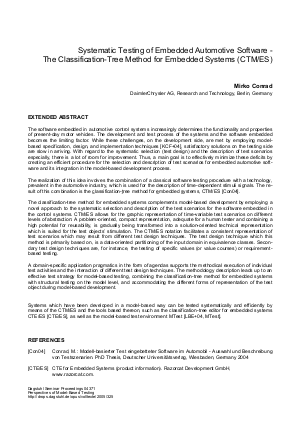@InProceedings{conrad:DagSemProc.04371.4,
author = {Conrad, Mirko},
title = {{Systematic Testing of Embedded Automotive Software - The Classification-Tree Method for Embedded Systems (CTM/ES)}},
booktitle = {Perspectives of Model-Based Testing},
pages = {1--2},
series = {Dagstuhl Seminar Proceedings (DagSemProc)},
ISSN = {1862-4405},
year = {2005},
volume = {4371},
editor = {Ed Brinksma and Wolfgang Grieskamp and Jan Tretmans},
publisher = {Schloss Dagstuhl -- Leibniz-Zentrum f{\"u}r Informatik},
address = {Dagstuhl, Germany},
URL = {https://drops-dev.dagstuhl.de/entities/document/10.4230/DagSemProc.04371.4},
URN = {urn:nbn:de:0030-drops-3257},
doi = {10.4230/DagSemProc.04371.4},
annote = {Keywords: Model-based Testing, Classification-tree Method for Embedded Systems (CTM/ES), test design technique, test notation}
}

 Creative Commons Attribution 4.0 International license
Creative Commons Attribution 4.0 International license
